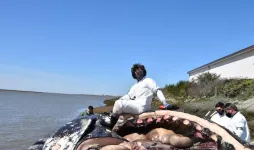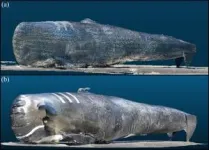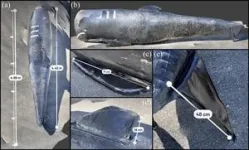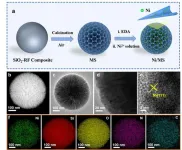(Press-News.org) What inspired you to become a researcher?
My interest in research began with an early love for nature, particularly the ocean and its wildlife. Drawn to conservation, I am fascinated by how technology can help study and protect marine mammals.
Can you tell us about the research you’re currently working on?
This research focuses on using accessible 3D scanning technologies, like LiDAR-equipped mobile devices and UAV photogrammetry, to document and analyze stranded marine mammals. LiDAR (Light Detection and Ranging) is a remote sensing technology that uses laser pulses to determine the distance between the instrument and a target surface or object. Distance is determined through a measure of the time it takes for the pulses to travel to the surface and be reflected to the sensor. The resulting output, typically a 3D point cloud, provides a detailed representation of surfaces and objects. In contrast, photogrammetry is a technique used to create 3D models from 2D photographs by capturing a series of overlapping photographs from different angles and processing with specialized software. By integrating these tools into necropsy procedures, I aim to improve morphometric data collection, enhance postmortem documentation, and create interactive visualizations for research, education, and conservation. This work is particularly valuable for remote large whale strandings, where traditional methods may be limited.
You used an iPhone12 for your work. Could –in theory– anyone equipped with a phone with a LiDAR sensor and the app make a 3D scan? What, if any, training is necessary?
Yes, in theory, anyone with a LiDAR-equipped phone (like an iPhone 12 Pro or later) and the right app, such as Scaniverse, could create a 3D scan of a stranded marine mammal. The process is designed to be user-friendly, but some basic training is beneficial to ensure high-quality and accurate scans. Key aspects of training would include understanding optimal scanning angles and distances, ensuring full coverage of the specimen, managing environmental challenges (eg, glare from wet surfaces or low-light conditions), and using the app’s measurement tools correctly. While the technology is highly accessible, proper technique helps maximize accuracy and usability for research and conservation purposes, which is hopefully highlighted in the paper.
What information can 3D reconstructions provide that might not be obtainable using traditional measurements in the field?
3D reconstructions offer a level of detail and versatility that traditional field measurements cannot always achieve. They provide a complete digital record of a specimen, allowing for precise morphometric assessments, post-examination measurements, and reanalysis without needing the physical carcass. Unlike traditional measurements, which can be limited by access, time constraints, or environmental conditions, 3D models capture full-body shape, external lesions, and anatomical structures in context, enabling comparisons across specimens and species. Additionally, these reconstructions can be used for visualization in education, response training, and conservation planning which expands their impact beyond the field.
In your opinion, why is your research important?
This research is important because it provides an accessible, low-cost method for documenting and analyzing stranded marine mammals, particularly in remote or resource-limited regions. By using widely available LiDAR-equipped mobile devices and free or inexpensive scanning apps, community responders and researchers can collect high-quality 3D data without the need for specialized or expensive equipment. This approach not only enhances morphometric accuracy and necropsy documentation but also democratizes data collection, allowing more regions to contribute to marine mammal conservation and health assessments without the barriers of cost or technical expertise.
Are there any common misconceptions about this area of research? How would you address them?
A common misconception is that 3D scanning is too complex for non-experts to use effectively. In reality, modern LiDAR-equipped smartphones and user-friendly apps make the process straightforward, requiring only basic training to capture highly accurate models.
What are some of the areas of research you’d like to see tackled in the years ahead?
I’d love to see more research integrating 3D scanning with other imaging modalities like MRI and CT to create a complete inside-out view of stranded marine mammals. Combining external 3D reconstructions with internal anatomical data could provide unique insights into pathology, trauma, and overall health. This approach would not only enhance necropsy documentation but also open new opportunities for virtual dissections, comparative studies, and education, allowing researchers and responders to better understand and preserve these incredible animals.
How has open science benefited the reach and impact of your research?
Open science has expanded the reach of this research by making the lessons learned available to a global audience. Sharing these tools also improves data collection and standardization, allowing responders and researchers worldwide to contribute to marine mammal conservation. By fostering collaboration and transparency, open science ensures that valuable stranding data is better collected, shared, and used to advance scientific and conservation efforts everywhere!
END
How one researcher equipped with a smartphone is creating detailed reports on the insides of stranded sea creatures
Q&A with Brendan Cottrell, who investigated the use of smartphones to create 3D scans of stranded marine life that can help scientists protect marine species
2025-03-05
ELSE PRESS RELEASES FROM THIS DATE:
Americans borrowed $74 billion last year to cover healthcare costs
2025-03-05
WASHINGTON, D.C. – March 5, 2025 – More than 31 million Americans (12%) report needing to borrow about $74 billion last year to pay for healthcare despite most having some form of health insurance, according to a new survey from West Health and Gallup. Nearly one-third (28%) report being “very concerned” that a major health event could throw them into debt.
The survey found almost 20% of Americans aged 49 and under needed to borrow money to cover medical costs compared with just 9% of those 50 to 64. Women between the ages of 50 and 64 were twice as likely as men in the same age group to say they had to borrow (12% vs. 6%). Two percent ...
Iconic Australian bird reveals hidden farming talent
2025-03-05
A beloved Australian bird best known for its stunning tail and powers of mimicry may have a cunning hidden talent.
New research has revealed the superb lyrebird to be a resourceful farmer, creating micro-habitats to host and fatten its prey before returning later to feast.
Scientists from La Trobe University observed the ground-dwelling birds working to create habitats suitable for their diet of worms, centipedes and spiders.
In a new paper published in the Journal of Animal Ecology, the researchers found that lyrebirds arranged litter and soil on the forest floor in ways that promote more ...
New method improves catalyst performance for hydrogenation reactions
2025-03-05
Recently, the research team led by Researcher WANG Guozhong from the Institute of Solid State Physics, the Hefei Institutes of Physical Science of the Chinese Academy of Sciences, has developed a method to precisely control the size of nickel particles in catalysts, improving their performance in hydrogenation reactions.
The related research results were published in Advanced Functional Materials.
Catalysts are essential in speeding up chemical reactions without being consumed, and the size of the metal particles in them plays a key role in their effectiveness. Larger particles have more high-coordination sites, while smaller ones are dominated ...
Cracking the code on gypsum and silica scaling in water desalination
2025-03-05
Mineral scaling, a significant issue in membrane desalination, reduces water recovery rates and diminishes system performance. Gypsum and silica, are two prevalent types of scaling, each form through different processes—crystallization for gypsum and polymerization for silica. These formation mechanisms lead to contrasting behaviors: gypsum scaling, marked by rapid kinetics and intrusive crystal growth, causes pore wetting, while silica scaling forms highly adhesive, irreversible layers. The impact of these scales on desalination efficiency underscores the need for a deeper understanding of their formation and mitigation.
On October 20, ...
Creativity boosts NAPLAN literacy and numeracy scores
2025-03-05
When ‘Elephant’ toothpaste erupts from the science lab, history deals up Pokémon playing cards, and maths bakes a batch of chocolate brownies, it might seem like chaos.
Yet, a groundbreaking study from University of South Australia researchers, shows that creativity plays an essential role in academic success, suggesting that students who think outside the box are more likely to excel in literacy and numeracy assessments.
It’s an important finding, particularly when the most recent National Assessment Program – Literacy and Numeracy (NAPLAN) data shows that one in three Australian students are behind in their numeracy ...
Beyond our solar system: scientists identify a new exoplanet candidate
2025-03-05
Scientists from UNSW Sydney have located a potential new exoplanet – a planet that orbits a star outside of our solar system – using a technique known as ‘transit timing variation’.
In research highlighted in a new paper, published today in The Astrophysical Journal, Scientia Senior Lecturer Ben Montet and PhD candidate Brendan McKee analysed changes in the timing of a known planet’s transit across its star, to infer the presence of a second exoplanet.
After ...
Amphibians bounce-back from Earth’s greatest mass extinction
2025-03-05
Ancient frog relatives survived the aftermath of the largest mass extinction of species by feeding on freshwater prey that evaded terrestrial predators, University of Bristol academics have found.
In the study, published today in the journal Royal Society Open Science, their findings suggest the amphibians’ success lay in their generalist feeding ecology, enabling them to feed on a wide variety of prey despite the array of environmental changes happening all around them through the Triassic. Broader examination of Triassic ecosystems also indicates that the freshwater habitats they preferred provided them with a relatively stable variety of food resources, allowing them ...
Better semen quality is linked to men living longer
2025-03-05
Men’s semen quality is associated with how long they live according to a study of nearly 80,000 men, which is published today (Wednesday) in Human Reproduction [1], one of the world’s leading reproductive medicine journals.
The study followed the men for up to 50 years and found that those with a total number of motile sperm (sperm that can move or ‘swim’) of more than 120 million could expect to live two to three years longer than men with a total motile sperm count of between 0 and 5 million.
This is the largest study to examine the link between semen quality and mortality. An accompanying editorial ...
Enhancing mosquito repellent effectiveness
2025-03-05
RIVERSIDE, Calif. -- In a recent study, researcher Anandasankar Ray at the University of California, Riverside, and his team employed machine learning techniques combined with cheminformatics to predict novel mosquito repellents that could greatly improve global mosquito control efforts. Using the same approach to combat the global threat of mosquito-borne diseases such as malaria and dengue, Ray, the recipient of a $2.5 million, five-year grant from the National Institutes of Health, or NIH, will now work on identifying novel spatial mosquito repellents ...
Prenatal maternal stressors linked to higher blood pressure during first year after birth, study shows
2025-03-05
Psychosocial stress during pregnancy could lead to higher blood pressure during the first year postpartum according to research from Keck School of Medicine of USC.
The study, published in Hypertension and supported by the National Institutes of Health, investigated whether mothers who reported higher perceived stress and depressive symptoms during pregnancy, developed higher blood pressure in the four-year period after birth. The findings showed higher stress and depressive symptoms during pregnancy were associated with greater blood pressure during the first year postpartum, but associations diminished thereafter.
“Pregnancy ...
LAST 30 PRESS RELEASES:
Injectable breast ‘implant’ offers alternative to traditional surgeries
Neuroscientists devise formulas to measure multilingualism
New prostate cancer trial seeks to reduce toxicity without sacrificing efficacy
Geometry shapes life
A CRISPR screen reveals many previously unrecognized genes required for brain development and a new neurodevelopmental disorder
Hot flush treatment has anti-breast cancer activity, study finds
Securing AI systems against growing cybersecurity threats
Longest observation of an active solar region
Why nail-biting, procrastination and other self-sabotaging behaviors are rooted in survival instincts
Regional variations in mechanical properties of porcine leptomeninges
Artificial empathy in therapy and healthcare: advancements in interpersonal interaction technologies
Why some brains switch gears more efficiently than others
UVA’s Jundong Li wins ICDM’S 2025 Tao Li Award for data mining, machine learning
UVA’s low-power, high-performance computer power player Mircea Stan earns National Academy of Inventors fellowship
Not playing by the rules: USU researcher explores filamentous algae dynamics in rivers
Do our body clocks influence our risk of dementia?
Anthropologists offer new evidence of bipedalism in long-debated fossil discovery
Safer receipt paper from wood
Dosage-sensitive genes suggest no whole-genome duplications in ancestral angiosperm
First ancient human herpesvirus genomes document their deep history with humans
Why Some Bacteria Survive Antibiotics and How to Stop Them - New study reveals that bacteria can survive antibiotic treatment through two fundamentally different “shutdown modes”
UCLA study links scar healing to dangerous placenta condition
CHANGE-seq-BE finds off-target changes in the genome from base editors
The Journal of Nuclear Medicine Ahead-of-Print Tip Sheet: January 2, 2026
Delayed or absent first dose of measles, mumps, and rubella vaccination
Trends in US preterm birth rates by household income and race and ethnicity
Study identifies potential biomarker linked to progression and brain inflammation in multiple sclerosis
Many mothers in Norway do not show up for postnatal check-ups
Researchers want to find out why quick clay is so unstable
Superradiant spins show teamwork at the quantum scale
[Press-News.org] How one researcher equipped with a smartphone is creating detailed reports on the insides of stranded sea creaturesQ&A with Brendan Cottrell, who investigated the use of smartphones to create 3D scans of stranded marine life that can help scientists protect marine species







